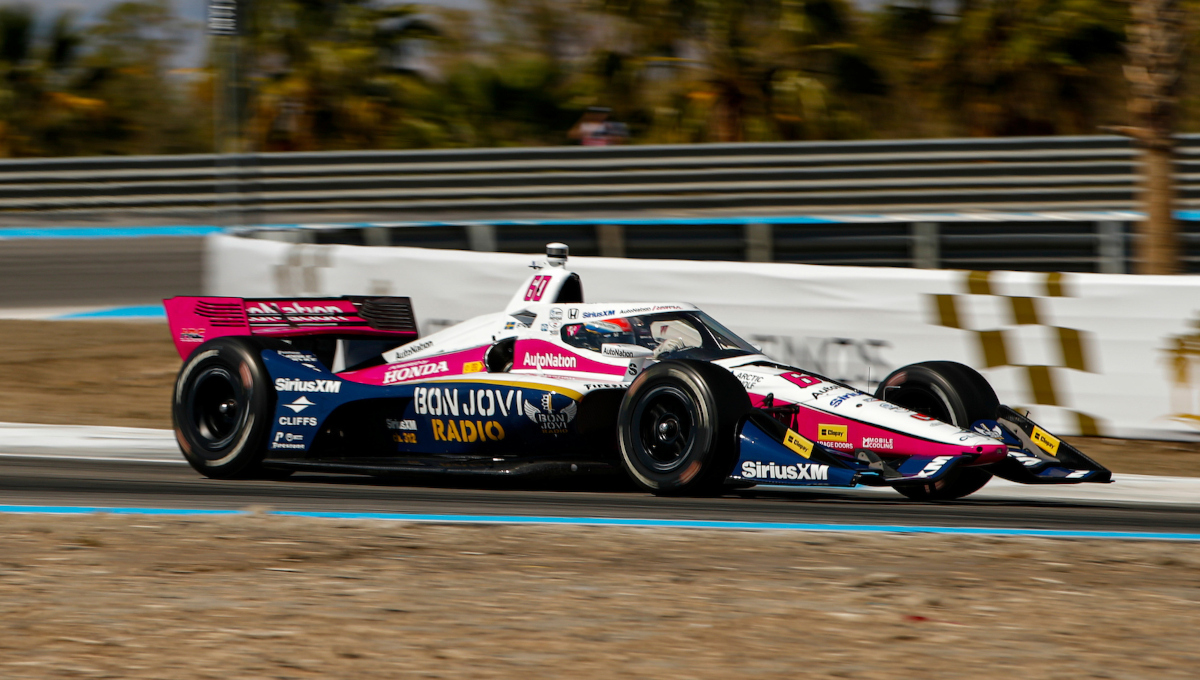Meyer Shank Racing earned its first NTT IndyCar Series pole on Saturday as new team leader Felix Rosenqvist placed the No. 60 Honda on top of the split field of drivers for Sunday morning’s first heat race with a lap of 1m38.583s.
Among the 14 drivers in Rosenqvist’s group, Team Penske’s Scott McLaughlin was second, Ed Carpenter Racing’s Rinus VeeKay was third, Rahal Letterman Lanigan Racing’s Christian Lundgaard was fourth, and the rest of the Penske trio in Josef Newgarden and Will Power completed the top six as drivers got to use an extra and brief bump of horsepower from push-to-pass.
“When we showed up here, people were eating ice cream and it was chill, and now it feels normal,” Rosenqvist told RACER of the switch from open testing to qualifying. “Because no one’s done this — like the push-to-pass deal — like, you’re one and done. If you must mess up that lap, you’re there in the back. I think it’s pretty cool.”
Chip Ganassi Racing’s Alex Palou led the other half of the grid for Sunday’s second heat race, lapping the 17-turn road course with a 1m38.567s tour in the No. 10 Honda to lead the 13 drivers in his group. Palou was shadowed in second by teammate Marcus Armstrong, RLL’s Graham Rahal, Ganassi’s Linus Lundqvist, MSR’s Tom Blomqvist, and RLL’s Pietro Fittipaldi in sixth.
A crash by Andretti Global’s Marcus Ericsson capped a bad day for the team, and with a red flag to retrieve the uninjured Swede’s car, the remaining drivers had an out lap and one flying lap to try and dislodge Arrow McLaren’s Callum Ilott from pole. Palou was ripe for the challenge.
“I love it,” Palou said. “Those are the best moments, honestly. The tires are cooked. No more push-to-pass. You don’t have a lot of time, but it’s awesome. That’s what we love about motorsport when it goes right and when it goes wrong.”’
[lawrence-auto-related count=3 category=1408]
With the fields set for the two heat races, Sunday’s activities will follow a tight timeline as IndyCar works within the live TV window offered by NBC.
“Each heat race will consist of 10 laps or be timed at 20 minutes,” IndyCar wrote. “Laps under full course yellow will not count, however, the race clock will continue. A lap is deemed complete when the leader crosses the start-finish line. The cars’ position on track will be determined by the last timeline crossed on track at the moment of the full course yellow condition.
“A new set of Firestone Firehawks will be allotted for the heat races. Pit stops for emergency service only will be allowed. Tires used during qualifying will be the only approved replacement tire(s) and must be approved by IndyCar. A car making an adjustment not deemed emergency in nature will be disqualified. As in qualifying, cars will receive 40-seconds of push-to-pass in each race.”
Once the top six finishers from each heat are identified, the event’s grand finale will take place.
“The top six advancing cars from each heat race will make up the 12-car field for the $1 Million Challenge,” IndyCar continued. “The pole position and odd number starting positions are determined by the heat race winner with the fastest time from qualifications occupying the pole and the remainder of that heat race line up in positions 3, 5, 7, 9 and 11. The final will consist of 20 laps divided into two 10-lap sprint segments with a 10-minute ‘halftime’ break following the completion of lap 10.”
During halftime, all cars will be refueled and teams can adjust tire pressures and wing settings. After halftime, IndyCar will reset the 40-second push-to-pass for the field.
Coverage of the heat races through the $1 Million Challenge begins at 9:30 a.m. PT.
